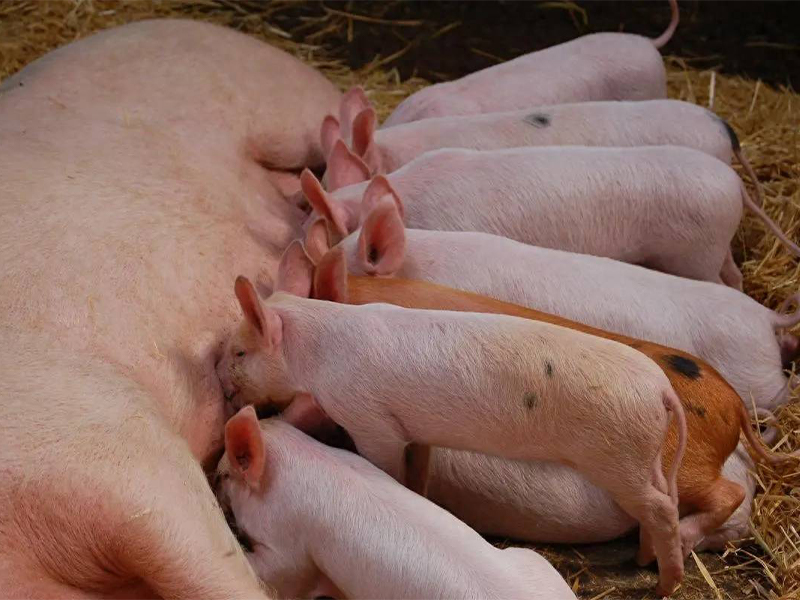1. When pigs are barking in excrement or wet places, their limbs are spread out when lying down, their bodies are fully stretched, and their breathing speeds up or they open their mouths to gasp. ——It tells you that the ambient temperature is too high, turn on the electric fan quickly.
2. The pigs curl up their bodies, tighten their limbs, and sleep in a pile. ——It tells you that the temperature is too low, they are cold.
3. When your pig is not sleeping, he is naughty, excited and likes to look around. ——That’s telling you to hurry up and start eating. It’s hungry.
4. Sows will make nests, breastfeed and perform other activities of raising piglets before and after giving birth. If these habits are not strong. ——It’s telling you that it is not satisfied with the benefits!
5. Pigs are accustomed to moving, living and sleeping in groups. When pigs are alone away from the herd. - It's telling you that it might be uncomfortable.
6. If the pig is exhausted, walks swaying, has sluggish movements, slow reaction, or spins in the pen, or runs rampant or stands motionless. ——It may be telling you that it is seriously ill.
7. Pigs have pale conjunctiva, pale skin, inelastic skin, long and messy hair, and are emaciated. ——Then you have to understand that she may be anemic or malnourished or have internal diseases or chronic wasting disease.
8. When pigs are frightened, restless, running around, excited, and staring. ——It may be telling you that it has edema or poisoning or a neurological disease.
9. When the pig’s eye conjunctiva is congested, the skin is red, the nose plate is dry and cracked, and breathing is accelerated. ——You have to understand that it is telling you that it has inflammation or fever.
10. When the pig's skin turns purple, the conjunctiva of the eyes is purple, and the skin is unevenly hot and cold. ——You need to know that it may be caused by blood disorders or in the later stages of some diseases.
11. When the pig has secretions flowing out of the nasal cavity, the skin is cyanotic, breathing is strong, breathing time is prolonged, coughing or shortness of breath. ——That is telling you that there is a problem with its respiratory organs.
12. When there is fecal contamination around the anus of a pig, it must be diarrhea. ——Pig reminds you to check the feed, temperature and pay attention to its intestinal diseases.
13. When the pig's skin is rough, thick, flakey, and itchy, it rubs against the wall. ——Then you have to think of ringworm, eczema, parasites, and mosquitoes.
14. When the pig feces is dry and the pig does not defecate for a long time, it is difficult to defecate and the appetite is poor. ——Then it might be constipation.
15. When pig feces is clear as water or muddy, with frequent defecation, the feces is red and mixed with a large number of small bubbles and has a foul odor. ——It means your pig may have food poisoning, intestinal parasitic diseases, certain infectious diseases or hemorrhagic enteritis.

2. The pigs curl up their bodies, tighten their limbs, and sleep in a pile. ——It tells you that the temperature is too low, they are cold.
3. When your pig is not sleeping, he is naughty, excited and likes to look around. ——That’s telling you to hurry up and start eating. It’s hungry.
4. Sows will make nests, breastfeed and perform other activities of raising piglets before and after giving birth. If these habits are not strong. ——It’s telling you that it is not satisfied with the benefits!
5. Pigs are accustomed to moving, living and sleeping in groups. When pigs are alone away from the herd. - It's telling you that it might be uncomfortable.
6. If the pig is exhausted, walks swaying, has sluggish movements, slow reaction, or spins in the pen, or runs rampant or stands motionless. ——It may be telling you that it is seriously ill.
7. Pigs have pale conjunctiva, pale skin, inelastic skin, long and messy hair, and are emaciated. ——Then you have to understand that she may be anemic or malnourished or have internal diseases or chronic wasting disease.
8. When pigs are frightened, restless, running around, excited, and staring. ——It may be telling you that it has edema or poisoning or a neurological disease.
9. When the pig’s eye conjunctiva is congested, the skin is red, the nose plate is dry and cracked, and breathing is accelerated. ——You have to understand that it is telling you that it has inflammation or fever.
10. When the pig's skin turns purple, the conjunctiva of the eyes is purple, and the skin is unevenly hot and cold. ——You need to know that it may be caused by blood disorders or in the later stages of some diseases.
11. When the pig has secretions flowing out of the nasal cavity, the skin is cyanotic, breathing is strong, breathing time is prolonged, coughing or shortness of breath. ——That is telling you that there is a problem with its respiratory organs.
12. When there is fecal contamination around the anus of a pig, it must be diarrhea. ——Pig reminds you to check the feed, temperature and pay attention to its intestinal diseases.
13. When the pig's skin is rough, thick, flakey, and itchy, it rubs against the wall. ——Then you have to think of ringworm, eczema, parasites, and mosquitoes.
14. When the pig feces is dry and the pig does not defecate for a long time, it is difficult to defecate and the appetite is poor. ——Then it might be constipation.
15. When pig feces is clear as water or muddy, with frequent defecation, the feces is red and mixed with a large number of small bubbles and has a foul odor. ——It means your pig may have food poisoning, intestinal parasitic diseases, certain infectious diseases or hemorrhagic enteritis.


